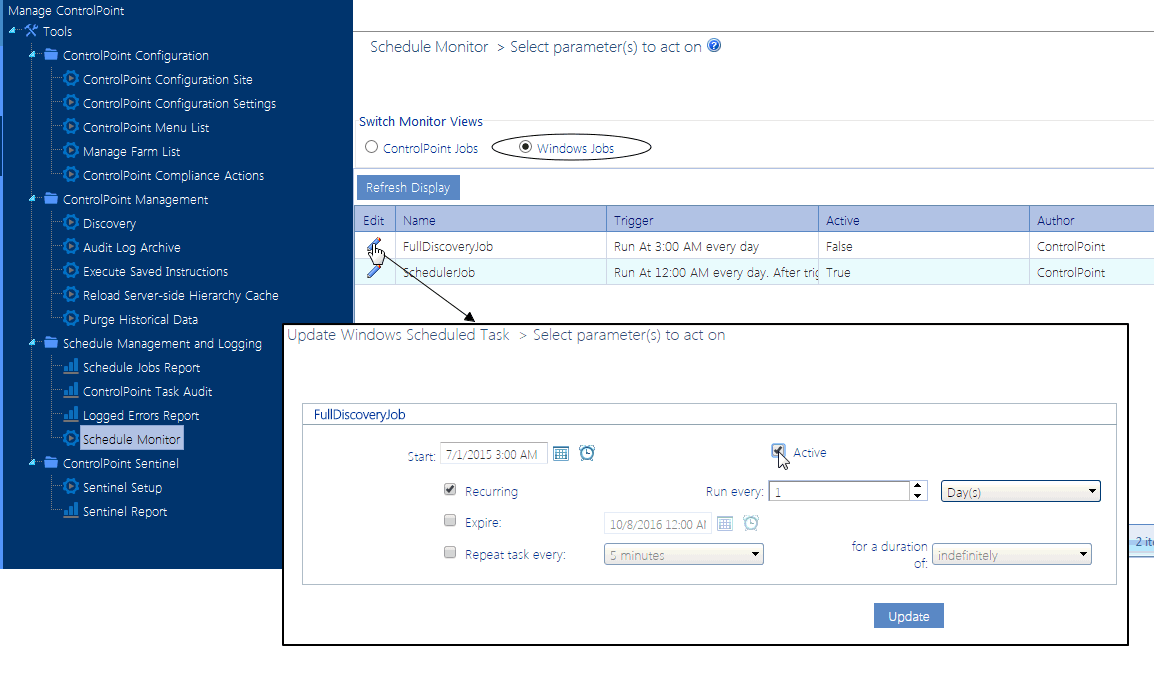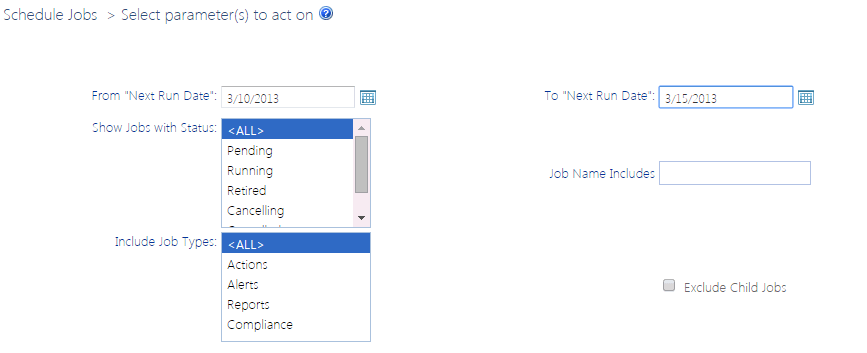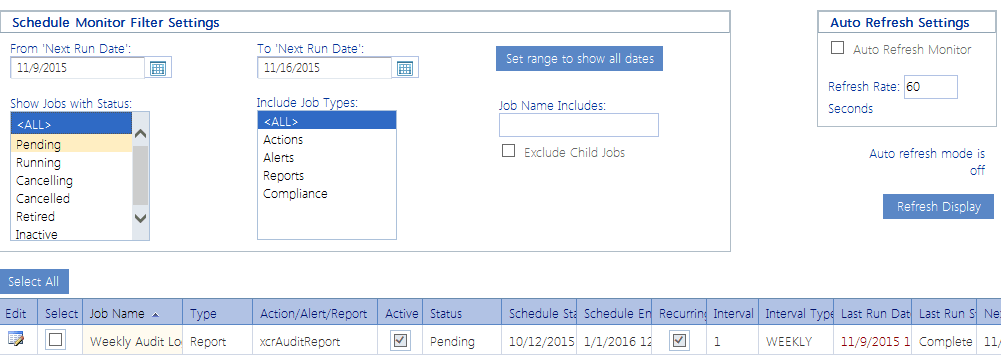Canceling or Deleting a Scheduled Job
From the Schedule Monitor you can:
·cancel a running instance of a scheduled job
OR
·completely delete one or more scheduled jobs.
NOTE: If you delete a job that has already run, any history associated with the job will also be deleted.
REMINDER: Delete and Cancel options are disabled if Auto Refresh is enabled.
To stop a running instance of a scheduled job:
NOTE: You can only stop instances of jobs that are currently running, and this action does not delete either the job itself or any future instances of a recurring job.
1In the In the Select column, check the box beside each running job instance you want to stop.*
2Click [Stop Selected].
To delete one or more scheduled jobs:
1In the Select column, check the box beside each job you want to delete.*
2Click [Delete Selected].
You will be prompted to confirm the deletion before the operation is carried out.
To delete all scheduled jobs:
1Click [Select All].
2Click [Delete Selected].
You will be prompted to confirm the deletion before the operation is carried out.
*NOTE: If you want to de-select currently selected jobs, click [Reset].
Updating Full Discovery and Scheduler Windows Jobs
As part of the initial configuration of ControlPoint Online, the following tasks are created in the Windows Task Scheduler on the server where ControlPoint Online is installed:
·the ControlPoint FullDiscovery job, scheduled by default to run once a day to populate the ControlPoint data cache.
IMPORTANT: The FullDiscovery job is disabled by default, and should be disabled if the ControlPoint Discovery Service will be used instead.
·the ControlPoint Scheduler Job, scheduled to run by default ever 10 minutes to check for and initiate the running of operations scheduled via the ControlPoint Scheduler.
You can activate/deactivate and change the default start time and/or frequency with which these jobs run via the Schedule Monitor Windows Jobs view.
CAUTION: Full Discovery and Scheduler are application-wide jobs. Changing the start time and or/frequency will impact all of ControlPoint.
To update Full Discovery and/or Scheduler Windows Jobs:
1From the Schedule Monitor, select the Windows Jobs radio button.
2Click the Edit icon for the job whose schedule you want to update.
3Update the Start date, time, and/or run frequency, as applicable.
4Click [Update].
Generating a Scheduled Jobs Report
The Scheduled Jobs Report provides the same information as the Schedule Monitor.
To generate a Scheduled Jobs Report:
1From the Manage ControlPoint panel, choose Schedule Management and Logging > Scheduled Jobs Report.
If you want to change the default date range, enter or select a From "Next Run Date" and To "Next Run Date"
NOTE: Next Run Date identifies:
§the next date/time a Pending job is scheduled to run
§the last date/time a Retired or Inactive job ran
§the start date/time that an in-process job started running.
2Select one or more Status values from the list box. Use the information in the table below for guidance.
NOTE: You can select multiple status values using the [CTRL] or [SHIFT] in the conventional manner. If you want to view all scheduled jobs for the specified date range, select All.
|
Status |
Description |
|---|---|
|
Pending |
All jobs that are scheduled to run within the specified date range. Pending jobs include: ·one-time jobs that have not yet run AND ·recurring jobs that have not yet reached their End Date. |
|
Running |
All scheduled jobs that are currently running (as long as the specified date range includes the current date). |
|
Cancelling |
All running jobs for which the current instance is in the process of being cancelled. |
|
Cancelled |
All jobs for which the last running instance was cancelled. |
|
Inactive |
Jobs that are not currently active but were created or last ran during the specified date range. |
|
Retired |
Jobs that finished running within the specified date range. Retired jobs include: ·one-time jobs that have already run AND ·recurring jobs that have reached their End Date. |
3If you want to further filter your results, use the information in the table below for guidance.
|
If you want to ... |
Then ... |
|---|---|
|
exclude site admin-specific "sub-jobs" that are created when a scheduled job is created with the Create Reports by Selection Hierarchy box checked |
check the Exclude Child Jobs box.. |
|
include only jobs of one or more specific types (Actions, Alerts, and/or Reports) (all job types are included by default) |
highlight the job type(s) you want to include in the Include Job Type(s) list box. |
|
display only jobs whose name includes a specified text string |
complete the Job Name Includes: field with a full or partial job name. |
Now you can:
·run the operation immediately (by clicking the [Run Now] button)
OR
·schedule the operation to run at a later time or on a recurring basis.
OR
·save the operation as XML Instructions that can be run at a later time.
From Scheduled Jobs Report results you can view a job's run history.
Saving, Modifying and Executing Instructions for a ControlPoint Operation
All schedulable ControlPoint operations can be saved in an XML file as "instructions" and run at a later time. If an operation has parameters that are modifiable, you can modify them in the XML file before running the job.
NOTE: Currently you cannot run instructions for multi-farm operations.





